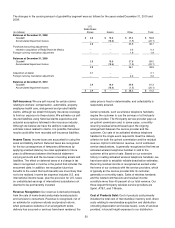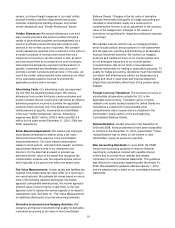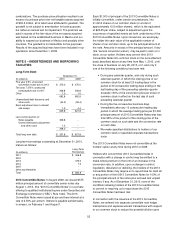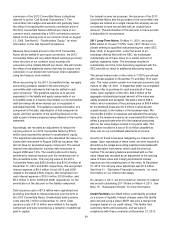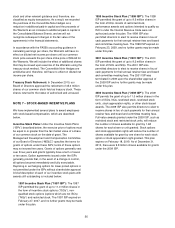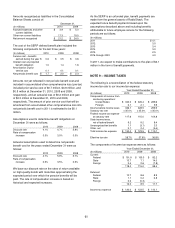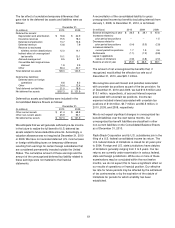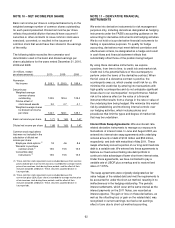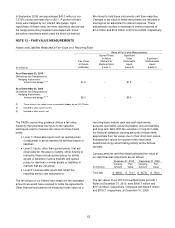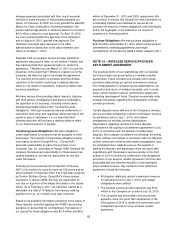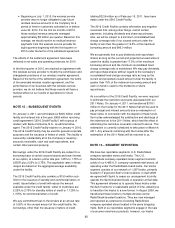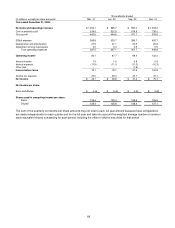Radio Shack 2010 Annual Report Download - page 69
Download and view the complete annual report
Please find page 69 of the 2010 Radio Shack annual report below. You can navigate through the pages in the report by either clicking on the pages listed below, or by using the keyword search tool below to find specific information within the annual report.
59
NOTE 8 – EMPLOYEE BENEFIT PLANS
The following benefit plans were in place during the periods
covered by the financial statements.
RadioShack 401(k) Plan: The RadioShack 401(k) Plan
(“401(k) Plan”), a defined contribution plan, was most
recently amended and restated effective July 1, 2010, and
allows a participant to defer, by payroll deductions, from 1%
to 75% of the participant’s annual compensation, limited to
certain annual maximums set by the Internal Revenue
Code. The 401(k) Plan also presently provides that our
contribution to each participant’s account maintained under
the 401(k) Plan be an amount equal to 100% of the
participant’s contributions up to 4% of the participant’s
annual compensation. This percentage contribution made
by us is discretionary and may change in the future. Our
contributions go directly to the 401(k) Plan and are made in
cash and invested according to the investment elections
made by the participant for the participant’s own
contributions. Company contributions to the 401(k) Plan
were $6.2 million, $6.6 million and $7.2 million for 2010,
2009 and 2008, respectively.
Supplemental Executive Retirement Plan: Prior to
January 1, 2006, certain officers of the Company were
participants in RadioShack’s Salary Continuation Plan
(“SCP”) or its Deferred Compensation Plan (“DCP” and,
together with the SCP, the “Plans”), which provided a
defined benefit to be paid out over a ten-year period upon
retirement between the ages of 55 and 70. Participation in
the Plans and the benefit payments were based solely on
the discretion and approval of the MD&C, and the benefit
payments did not bear any relationship to a participant’s
present compensation, final compensation or years of
service. We accrued benefit payments earned based on the
provisions set forth by the MD&C for each individual
person. Based on the method by which the Plans were
administered and because there was not a specific plan
governing the benefit payment calculation, the accounting
and disclosure provisions of the FASB’s accounting
guidance for pensions were not previously required.
The Company adopted an unfunded Supplemental
Executive Retirement Plan (“SERP”) effective January 1,
2006, for selected officers of the Company. The SERP was
most recently amended and restated effective as of
December 31, 2010. Upon retirement at age 55 years or
older, participants in the SERP are eligible to receive, for
ten years, an annual amount equal to a percentage of the
average of their five highest consecutive years of
compensation (base salary and bonus), to be paid in 120
monthly installments. The amount of the percentage
increases by 2 ½% for each year of participation in the
SERP, up to a maximum of 50%.
To be a participant in the SERP, officers who were
participants in the SCP or DCP had to withdraw from the
applicable plan and would then only receive benefits under
the SERP. The benefits for these officers are calculated
under the SERP using a formula that calculates the benefit
under each plan (SERP, SCP or DCP) and pays the
participant the highest dollar benefit.
If a SERP participant terminates employment due to
retirement or disability between the ages of 55 and 70, the
participant is entitled to their normal vested SERP benefit,
paid in 120 equal monthly payments.
Based on the effective date of the SERP of January 1,
2006, fiscal year 2006 was the initial year in which an
actuarial valuation was performed. The projected benefit
obligation at the beginning of 2006 represents the actuarial
valuation that was performed as of January 1, 2006, based
on the information and assumptions developed at that time.
Participants in the SERP as of January 1, 2006, were given
credit for prior service as an officer of the Company.
Therefore, this service credit generated prior service costs
that are not required to be immediately recognized, but that
are amortized for purposes of the net periodic benefit cost
calculation over the estimated average remaining service
period for active employee participants.
We use the last day of our fiscal year as the measurement
date for determining SERP obligations and conduct an
actuarial valuation at that date. The change in benefit
obligation, plan assets, and funded status for 2010 and
2009 are as follows:
Year Ended
December 31,
(In millions) 2010 2009
Change in benefit obligation:
Benefit obligation at
beginning of year
$ 24.0
$ 26.5
Service cost – benefits earned
during the year
0.6
0.5
Interest cost on projected
benefit obligation
1.0
1.4
Actuarial loss 0.5 0.8
Benefits paid (4.9) (5.2)
Benefit obligation at end of year 21.2 24.0
Change in plan assets:
Fair value of plan assets at
beginning of year
--
--
Employer contribution 4.9 5.2
Benefits paid (4.9) (5.2)
Fair value of plan assets
at end of year
--
--
Underfunded status $ (21.2) $ (24.0)
The accumulated benefit obligation was $20.6 million and
$22.9 million at December 31, 2010 and 2009, respectively.



